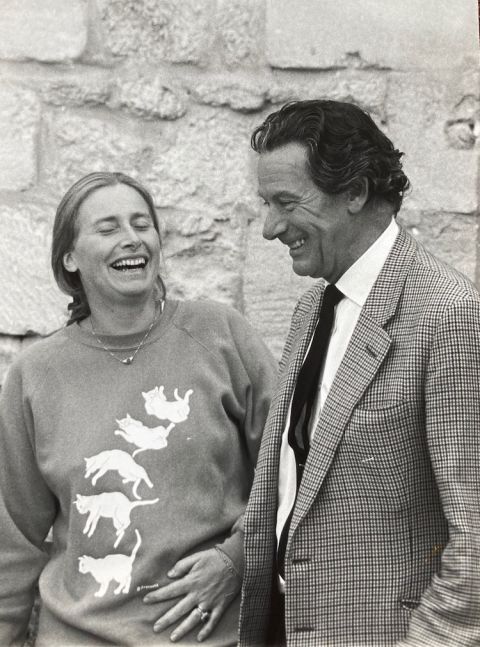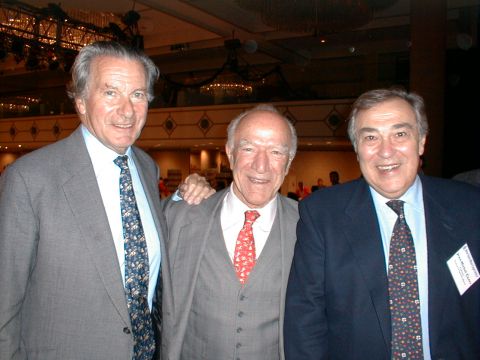5 February 2022 A follow-up to this news of the demise of one of the most popular Bordeaux proprietors, pictured here by his granddaughter Mélanie Barton Sartorius. A shorter version of this article is published by the Financial Times.
Anthony Barton of Chx Langoa Barton and Léoville Barton was buried in the vines of St-Julien last month, marking the end of an era in the Bordeaux wine business. Most unusually, these two estimable Médoc classed growths have been in the same family, an Anglo-Irish family in this case, since the 1820s. Although doubtless many tried to persuade him to sell, Barton was financially independent and never had to go cap in hand to a bank or one of the insurance companies that now own so many Bordeaux châteaux. Nor was he interested in playing the game still popular among Bordeaux château owners of proving that he could command a higher price than his neighbours. He simply wanted to make good wine that his long-standing end-customers could afford to drink. ‘There are only so many new cars you need’, he would tell journalists.
Most famously, when the distinctly unexciting 1997 vintage was released at far too high a price by most proprietors, buoyed by the success of the much more impressive 1995 and 1996 vintages, Barton stuck to his (relatively) modestly priced guns. He did not make himself more popular with the Bordeaux trade thereby but he did forever earn himself many a friend among wine drinkers. His pricing may have nudged up a bit in subsequent years, but he always enjoyed a well-earned reputation for fairness.
Below is a note kindly supplied by Edmund, son of the late Bordeaux expert Edmund Penning-Rowsell, on which he recorded release prices of vintages 1982 to 1995 for, left to right, Léoville Barton, Pichon Lalande, Léoville Poyferré and Cos d'Estournel.
I remember Anthony Barton observing to me wryly at the start of this century, a century during which château owners seem to have been transforming their ever-increasing income into ever-grander bricks and mortar, that the Médoc had been invaded by cranes. The only building work undertaken by the Barton family in St-Julien has been entirely focused on improving the winemaking facilities.
But then Anthony and Eva Barton did live in Ch Langoa Barton, one of the most beautiful buildings in the Médoc, a single-storey chartreuse described by the late Michael Broadbent of Christie’s as combining ‘the very best of French and English taste, both in the gardens, and its beautiful interior’. (Ch Léoville Barton, being one-third of the original Léoville estate, does not have its own château and shares cellars with Langoa, the third growth whose wine is not quite as classically reserved as second growth Léoville Barton.)
‘Twas not always thus. Anthony arrived in Bordeaux, after Stowe and Cambridge, in 1951 at the age of 21 but was kept very much at a distance by his uncle Ronald who ran Langoa. It was not until 1985 that Anthony was allowed to make the wine, and he and Eva were able to move into Langoa only the following year when Anthony was almost 56.
Langoa in the Ronald era played a part in the FT’s wine coverage; in 1964, the year he first wrote for the paper, my predecessor Edmund Penning-Rowsell was allowed to camp in the grounds with his family when researching his comprehensive book The Wines of Bordeaux. In it he notes how the first Barton to work in the Bordeaux wine trade, Thomas who arrived in 1722 and founded the wine merchant Barton & Guestier, went on to buy properties in the Médoc (not yet the two St-Juliens) and became the most significant buyer of the wines that would a century later be classified as the first growths.
Wine may have coursed through Anthony Barton’s veins but for much of the mid 20th century he was a lowly wine salesman, first with Barton & Guestier and subsequently for his own company Vins Fins Anthony Barton. On being made Decanter Man of the Year in 2007 he told the magazine’s Stephen Brook, ‘I wasn’t allowed to handle the two Bartons, which were sold through Barton & Guestier. So I had to make money by selling, for example, off-dry white to the Finnish monopoly. It was fairly nasty stuff, but they couldn’t get enough of it.’
Dry wit, and sartorial elegance, were Barton trademarks. In his autobiography Wine: A Life Uncorked wine writer Hugh Johnson describes Anthony Barton as ‘a Médoc landmark himself. When the pleasantries of tasting turn pretentious, a thing not unknown in the grander châteaux, the tall saturnine Anthony pricks the bubble.’ Barton was always wonderfully approachable. And hospitable. Langoa’s elegant reception rooms must have seen a fair proportion of the world’s wine professionals pass through them. He gamely allowed us to film there when I made a TV series for the BBC in the mid 1990s which also involved driving me round the Médoc in an open-top car with camera attached as he explained the hierarchy of Médoc entertaining.
As one of the remarkably few Médoc classed-growth owners who actually lived in his château, Anthony with Eva were popular and frequent guests when, for example, Ch Latour was in English hands (and in part a sister company to the FT). Our filming took place soon after the first growth had been sold to François Pinault, and Barton mused on camera about whether this ‘French businessman’ would continue the tradition of entertaining him there. He, rightly, doubted it.
Another prominent Médoc resident, Jean-Michel Cazes of Ch Lynch-Bages in Pauillac, was a great friend of Barton and the two of them often travelled together in the era when such wine luminaries were feted abroad, especially in the US. Cazes, who kindly supplied the three images above, wrote to me, ‘Anthony was a true friend. Over a period of 30 years, we travelled together many thousand miles, made friends around the world and had a great time. Anthony was sincere, honest and down to earth, elegant and witty … A wonderful companion. On top of that, we lived a couple of miles apart from each other. Being among the very few Médoc vintners who actually live full-time in the vineyard, we used to call ourselves the “Last of the Mohicans”!’
Cazes and Barton were almost impish in their humour, and clearly had enormous respect for each other rather than any sort of rivalry. You always wanted to be seated next to one of them at dinner because it felt like fun rather than work. Perhaps because of this, we were once bold enough to invite Anthony Barton to dinner with us in London. He was of course impeccably behaved and would forever refer to the particular way Nick sautéed leeks.
Unlike many famous Bordeaux proprietors during the era of the 1990s and 2000s when the scores of American wine guru Robert Parker virtually governed selling prices, Barton didn’t change the style of his wines to suit what was imagined to be Parker’s preference for plumped-up wine. Langoa and Léoville Barton remained dry, long-lived Médoc – albeit more nuanced and slightly fruitier wines than most of those made, with some pretty dodgy equipment, in the Ronald era. Even Penning-Rowsell admits in his book, ‘Ronald Barton is a conservative wine-maker, and in off-years his wines can be a little thin…’.
‘One of the nicest people in Bordeaux’, ‘urbane’, ‘courteous’ and ‘amusing’ are all descriptions I found in my inbox after I published a short appreciation of Barton here.
His legacy will live on because the next two generations are already fully involved with the family wine business: his daughter Lilian and her husband Michel Sartorius and their children Damien, shaping up to look like his grandfather, and Mélanie, who has been making wine at a property in nearby Moulis they bought in 2011, Ch Mauvesin Barton.
But the number of truly family-owned classed growths constantly dwindles. And those for which a benevolent pricing policy is in place is rapidly approaching zero.
Favourite Barton vintages
All wines I have scored at least 18 out of 20.
Ch Léoville Barton
1945, 1948, 1959, 1961, 1985, 1989, 1990, 1999, 2000, 2001, 2002, 2004, 2005, 2006, 2009, 2010, 2015, 2016, 2018, 2019, 2020
Ch Langoa Barton
1948, 1955, 1961, 1989, 2004, 2005, 2009, 2016
And look out for Ch Mauvesin Barton 2016, just £23.95 Davy’s Wine Merchants and £24.95 Mumbles Fine Wines.
Tasting notes in our tasting notes database. International stockists on Wine-Searcher.com.
Read all 45 articles in which Anthony Barton is mentioned.















